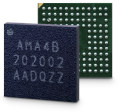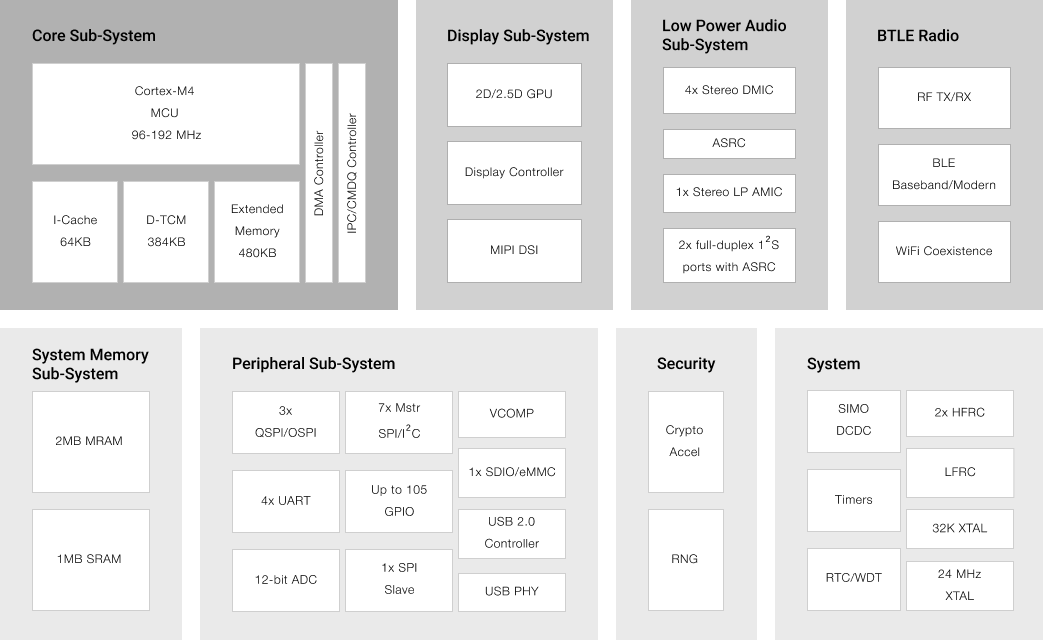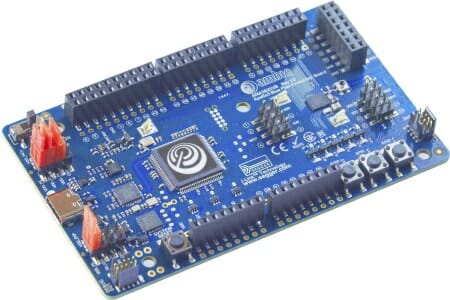
The fourth generation of ultra-low-power Apollo microcontroller has now been announced with Apollo 4 and Apollo 4 Blue microcontrollers – the latter adding Bluetooth – halving the power consumption of Apollo 3 at just 3µA/MHz, or ten times less than the original ultra-low-power MCU from the company.

Apollo 4 (Blue) specifications and key features:
- MCU Core – Arm Cortex-M4F core up to 192 MHz (TurboSPOT) with FPU, Memory Protection Unit (MPU), and Secure Boot
- GPU – 2D/2.5D graphics accelerator with full alpha blending, texture and frame buffer compression
- Ultra-Low Power Memory
- Up to 2MB of non-volatile MRAM for code/data
- Up to 1.8MB of low power RAM for code/data
- Display I/F – 2-lane MIPI DSI 1.2 up to 500 Mbps, up to 640 x 480 resolution with 4-layers with alpha blending, frame buffer decompression
- Audio
- 1x stereo low power Analog microphone
- 4x stereo Digital microphones
- 2x full-duplex I2S ports with ASRC
- Wireless Connectivity (Apollo 4 Blue only)
- Bluetooth Low Energy 5 up to 2 Mbps, extended advertising packets, AOA/AOD for direction finding
- Tx – 4 mA @ 0 dBm, Rx 4 mA
- Tx – -20 dBm to +10 dBm output power
- Rx Sensitivity – -97 dBm at 1 Mbps, -94 dBm at 2 Mbps
- Ultra-Low Power Interface for On- and Off-Chip Sensors
- 12-bit ADC, 11 selectable input channels
- Up to 2.8 MS/s sampling rate
- Temperature sensor with +/-3°C accuracy
- Ultra-Low Power Flexible Serial Peripherals
- 3x 2/4/8-bit SPI master interfaces
- Up to 8x I2C/SPI masters for peripheral communication
- 1x SPI slave for host communications
- 4x UART modules with flow control
- 1x USB 2.0 HS/FS device controller
- 1x SDIO (SD3.0)/1x eMMC (v4.51)
- Clock Sources – 16-52 MHz and 32.768 kHz Crystal (XTAL) oscillators; 1 kHz LFRC oscillator; 2x HFRC oscillator – 192/384 MHz
- Ultra-Low Supply Current
- 3 μA/MHz executing from MRAM (with cache)
- 3 μA/MHz executing from SRAM
- 1.5 μA low power sleep mode with RTC and 8KB SRAM retention
- Operating Voltage – 1.71-2.2 V; SIMO buck; Multiple I/O voltages supported
- Package Options
- Apollo 4
- 5 x 5 mm, 146-pin BGA with 105 GPIO
- 3.9 x 3.9 mm, 121-pin WLCSP with 82 GPIO
- Apollo 4 Blue – 4.7 mm x 4.7 mm, 131-pin SIP BGA
- Apollo 4
- Temperature Range –40°C to 85°C
- Process – TSMC 22nm ULL
Apollo 4 and Apollo 4 Blue are basically identical except for the latter adding Bluetooth 5 LE, and losing one I2C interface in the process. Packages are also different.
Applications listed by the company include smartwatches, wireless sensors and IoT, activity/monitors, motion and tracking devices, alarms and security systems, far-field voice remotes, consumer medical devices, predictive maintenance, and the smart home. The press release highlights Apollo 4 is especially well-suited to battery-powered smart IoT devices with always-on voice processing.

The company offers a development board for the new Apollo 4 microcontrollers with I/O headers, buttons, and USB-C port. There’s no public documentation for the board that I could find, however.
Visit the product page for further information.

Jean-Luc started CNX Software in 2010 as a part-time endeavor, before quitting his job as a software engineering manager, and starting to write daily news, and reviews full time later in 2011.
Support CNX Software! Donate via cryptocurrencies, become a Patron on Patreon, or purchase goods on Amazon or Aliexpress




